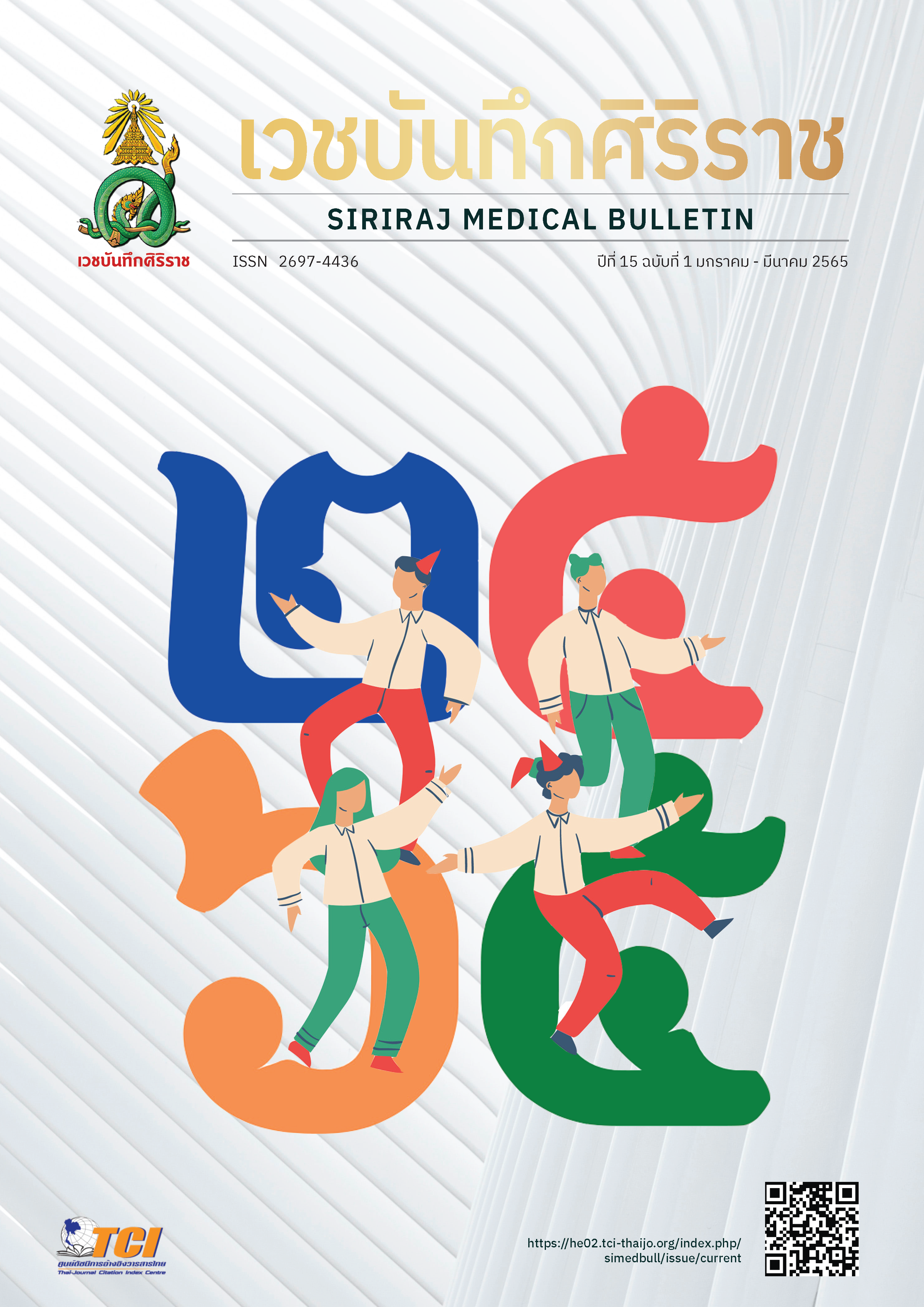Perioperative Medication Management in Joint Replacement Surgery
Main Article Content
Abstract
Joint replacement surgery is recognized as high risk bleeding operation. Hence the perioperative management of antithrombotic and anti-rheumatic drug is very important in order to balance postoperative bleeding, thromboembolic risk and risk of prosthetic joint infection. Antithrombotic drug consists of anticoagulant and antiplatelet. In the first step, physician has to evaluate thromboembolic risk in case patients have to stop taking antithrombotic drug. Physician should advise patients who take anticoagulant warfarin to stop taking it for 4-5 days before operating a surgery. However, for high thromboembolic risk patients, they should take bridging therapy in order to reduce thromboembolic effect. For patients who take direct oral anticoagulant (DOAC), they should stop taking DOAC for 3-4 days before surgery; there is no necessity to provide bridging therapy. For patients who take antiplatelet drugs, they should stop taking it for 5-7 days prior to surgery. Next step is to resume taking antithrombotic drug after operation when bleeding risk has diminished. Anti-rheumatic drug especially biological agents have a tendency to increase risk of infection after surgery, thus a very good plan in drug dosing cycle must be aligned with surgery schedule. After surgery for 14 days, patients should resume taking biological anti-rheumatic agents in case there are no surgical site infection, systemic infection, and wound healing problem.
Article Details
References
Sattler LN, Hing WA, Vertullo CJ. What is the evidence to support early supervised exercise therapy after primary total knee replacement? A systematic review and meta-analysis. BMC Musculoskeletal Disorders 2019; 20(42): 1-11.
Singha JA, Lewallen DG. Time trends in the characteristics of patients undergoing primary total knee arthroplasty. Arthritis Care Res (Hoboken) 2014 Jun; 66(6): 897–906.
Holbrook A, Schulman S, Witt DM, Vandvik PO, Fish J, Kovacs MJ, et al. Evidence-Based management of anticoagulant therapy: Antithrombotic therapy and prevention of thrombosis, 9th ed: American College of Chest Physicians Evidence-Based Clinical Practice Guidelines. Chest 2012; 141(2, Supplement): e152S-e84S.
Ortel TL. Perioperative management of patients on chronic antithrombotic therapy. Blood 2012 Dec 6; 120(24): 4669-705.
Lane DA, Lip GYH. Use of the CHA2DS2-VASc and HAS-BLED Scores to Aid Decision Making for Thromboprophylaxis in Nonvalvular Atrial Fibrillation. Circulation 2012; 126(7): 860-5.
Lip Gregory Y H, Nieuwlaat Robby, Pisters Ron, Lane Deirdre A, Crijns Harry J G M. Refining clinical risk stratification for predicting stroke and thromboembolism in atrial fibrillation using a novel risk factor-based approach: the euro heart survey on atrial fibrillation. Chest 2010; 137 (2): 263–72.
Hornor MA, Duane TM, Ehlers AP, Jensen EH, Brown PS, Pohl, et al. American College of Surgeons’ Guidelines for perioperative management of antithrombotic medication. J Am Coll Surg 2018; 227(5): 521-33.
Quintero JI, Cardenas LL, Navas M, Bautista MP, Bonilla GA, Llinas AM. Primary joint arthoplasty surgery: Is the risk of major bleeding higher in elderly patients? a retrospective cohort study. J Arthroplasty 2016; 31: 2664-8.
Carling MS, Jeppsson A, Erikkson BI, Brisby H. Transfusion and blood loss in total hip and knee arthoplasty: a prospective observational study. J Orthop Surg Res 2015; 10(48): 1-7.
Rossini R, Musumeci G, Viscinti LO, Bramucci E, Castigloni B, Servi SD, et al. Perioperative management of antiplatelet therapy in patients with coronary stents undergoning cardiac and non cardiac surgery: a consensus document from Italian cardiological, surgical and anaesthesiological societies. Euro Intervention 2014; 10: 38-46.
Becker DE. Antithrombotic Drugs: Pharmacology and Implications for Dental Practice. Anesth Prog 2013; 60:72–80.
Opera AD, Popescu WM. Perioperative management of antiplatelet therapy. Br J Anesth 2013; 111(Suppl 1): i3 – i7.
Douketis JD, Spyropoulos AC, Spencer FA, et al. Perioperative management antithrombotic therapy. Antithrombotic therapy and prevention of thrombosis, 9th ed: American Collage of Chest Physicians Evidence Based Clinical Practice Guidelines. Chest 2012; 141(2 Suppl) e326S – e350S.
Thammathinno V. Perioperative management of antithrombotic drug. TJHP 2017; 26(3): 163-77. (in Thai)
Lee H, Chiu K, Yiu K, Ng F, Yan C, Chan P. Perioperative antithrombotic management in joint replacement surgeries. Hong Kong Med J 2013; 19(6): 531-7.
Micromedex Healthcare Series 1974-2006. Thomson Healthcare Inc. Thomas Jefferson University Hospital, Philadelphia, PA. Available at: http://www-thomsonhc-com.proxy1.lib.tju.edu:2048/hcs/librarian/. Accessed on April 2020.
Godman SM, Springer B, Guyatt G, Abdel MP, Dasa V, George M, et. Al. 2017 American College of Rheumatology/ American Association of Hip and Knee Surgeons Guideline for the perioperative management of antirheumatic medication in patient with rheumatic disease undergoing elective total hip or total knee arthoplasty. Arthritis Care Res (Hoboken) 2017; 69(8): 1111-24.
Thai Rheumatism Association. Recommendation for using biologic disease modifying anti-rheumatic drugs: bDMARDs and targeted synthetic disease modifying anti-rheumatic drugs: tsDMARDs in treatment rheumatoid arthritis. Bangkok: City print Publishing; 2017. (in Thai)






